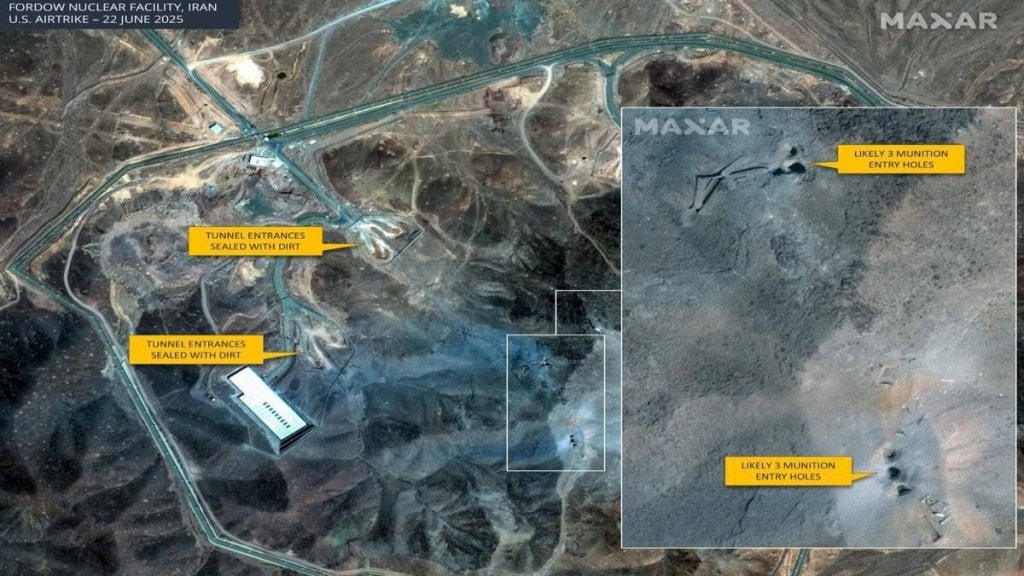Israel-Iran conflict: US President Donald Trump ordered American forces to strike three key Iranian nuclear sites – Fordow, Natanz, and Isfahan – under “Operation Midnight Hammer.” Trump told reporters that these targets were “totally obliterated” in the attack. However, military and nuclear analysts say it’s still unclear how much damage was really done.
What do we know about the destruction and damage?
B-2 stealth bombers flew overnight raids to drop heavy GBU-57 “bunker buster” bombs on underground facilities. Images taken after the strikes show small craters at Fordow and Natanz. Satellite photos from Maxar Technologies revealed holes on the mountain ridge at Fordow, near the entrances to its tunnels. One large building, which could control airflow to the underground halls, was left intact.
At Natanz, pictures showed a new crater, about 5.5 meters wide, right above the main enrichment site. However, the facility is buried deep underground, protected by a thick layer of concrete and steel. The International Atomic Energy Agency (IAEA) has not detected any radiation leaks so far.
What Trump said?
Trump on a Truth Social post said that only monumental damage was done to Iran nuclear sites and the biggest damage took place far below ground level which is not visible on satellite images.
“Monumental Damage was done to all Nuclear sites in Iran, as shown by satellite images. Obliteration is an accurate term! The white structure shown is deeply imbedded into the rock, with even its roof well below ground level, and completely shielded from flame. The biggest damage took place far below ground level. Bullseye!!!,” reads Trumps post.
Lack of evidence to prove Trump ‘successful’ attack on Iran nukes
US officials say they need more time to judge the “final battle damage.” Observers also note that the craters look too small to have come from the most powerful bunker-buster bombs. Some military experts believe these could have been lighter bombs or cruise missile strikes instead. Nothing points to serious collapse of Iran’s underground labs, at least so far.
The strikes have made it even harder for the IAEA to do its job. Inspectors usually visit these sites regularly to check the amount of enriched uranium and other nuclear material. But Iran recently broke the seals and moved most of its highly enriched uranium stockpile to unknown places. “We lost track of their bomb-grade uranium,” an IAEA official admitted.
Nuclear monitors now worry that these strikes will convince Iran to hide its program deeper and less openly, making future checks nearly impossible. “By bombing these facilities,” said one former IAEA chief inspector, “the US and Israel have disrupted the very tools we use to monitor Iran.”
What did Iran say?
Iranian leaders called the US strikes an attack on its sovereignty and threatened to respond. Some lawmakers in Tehran approved closing the Strait of Hormuz, a narrow waterway through which 20% of the world’s oil passes as one option. Foreign Minister Seyed Abbas Aragchi warned that “a variety of options are available,” signaling that Iran could strike US interests or its allies in the region.
Iran’s Supreme leader on Monday vowed punishment on ‘enemies’. His post on X (roughly translated from Urdu) reads, “The punishment continues. The Zionist enemy has made a big mistake, committed a big crime; it must be punished and it is being punished; it is being punished right now.”
What did analysts say?
In the US, Trump faces mixed reactions. Some supporters hail him for taking strong action. Others worry that this will worsen tensions in the Middle East. Analysts also believe these strikes were more of a political show to please hawks in Israel and Washington, while allowing Trump to say he had destroyed Iran’s nuclear program.
Satellite photos, however, suggest that Fordow and Natanz remain mostly intact. That gives Iran an incentive to go underground with its program and hide its next steps even further, creating new challenges for any future diplomatic or monitoring effort.

